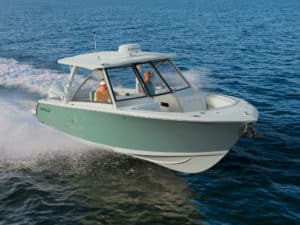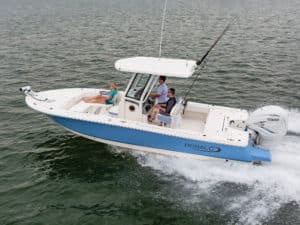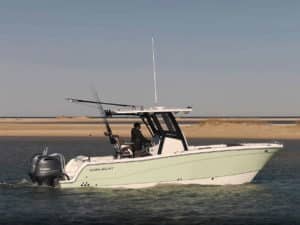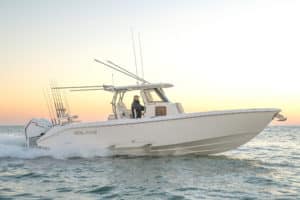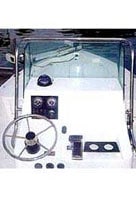
The “suits” at U.S. Marine finally made the decision. Given Robalo’s stronger name recognition, some Wahoo! models have been incorporated into the Robalo line (and you won’t be hearing the name Wahoo! again).
Formerly a 20-foot Wahoo! hull, this redesigned 2109 tunnel bay skiff has gained a little muscle, a little weight and a 30-inch-long tunnel. These refinements allowed it to run in about 8 inches of water and helped three of us each connect with Gulf inshore grand slams (snook, trout and redfish).
The 2109 (a sister ship to the 2100 Bayhunter) can run in even skinnier water than its sibling, thanks to the tunnel. This conical indentation channels water to the prop even when our boat’s hydraulic jack plate raised the blades flush with the bottom of the boat. The Bayhunter couldn’t run as shallow as we could, following us through the shallows around Boca Grande in Florida’s backcountry.
Performance
A Mercury 150-hp OptiMax engine pushed us to 42 mph at 5,350 rpm. I suppose you could re-prop it to gain some more revs – up to the max at 5,500 – but why bother? It runs great at 42 and allows you to stop more easily to avoid running over that sudden sandbar. Plus, the pitch of this prop provides better hole-shots for getting on a plane quicker in shallow water.
One thing I’d always be sure to have if using a jack plate (an aftermarket item in this case) is a water-pressure gauge. It’s too easy to overheat a jack-plated engine from lack of enough cooling water.
Anyone who’s run one knows that turning is not a flats skiff’s strong point. Due to the flat section aft, they tend to slide around turns at almost any speed. With its tunnel, the 2109 carves turns perfectly, making it easier to negotiate serpentine backcountry mangrove channels in search of game fish. Unlike most flats boats, the 2109 has no trim tabs. None are really needed either – except perhaps to balance out side-to-side weight distribution if you don’t want to ask your fat friend to move closer to centerline.
Fishing
Very simple flip-out racks for carrying rods under the gunwale handle three on each side, while vertical holders hold two on each side of the console. In fact, there are plenty of places for spinning gear, but it’ll take some smart and relatively easy re-rigging to oblige those who prefer to use fly tackle. Fly enthusiasts might also want to fit push-pole holders. Despite the boat’s 1,800-pound displacement, our captain, Steve Hogan, found it easier in many instances to push us 100 feet or so down the shoreline than to deal with the trolling motor.
Enough fish to feed us all dinner attested to the fact that the 2109 doesn’t scare fish away. Fishing three large men plus the guide posed no “room-to-work” problems whatsoever, even with two people fly casting and a third spinning. Overall, the 2109 Bayhunter fishes extremely well because it is well thought out and simple.
Design and Construction
Simplicity of both design and construction makes for a boat that works well and won’t break the bank. A large, carpeted, dry-storage compartment under the starboard foredeck can lock up more tackle than you’d ever bring aboard. A molded fish box mirrors it to port. Robalo has two built-in tackle storage boxes, and a molded toe rail around the bow is wide enough to accommodate a trolling motor mount.
The 2100 Bayhunter we fished alongside the 2109 sported an optional T-top, while the 2109 Tunnel did not. I found a significant difference in ease of fishing without the top. Not only is fly casting infinitely easier without the shade, movement around the boat and multi-person casting also proved easier.
Look into the actual construction of a Robalo and you’ll find solid, time-tested technology: foam-filled fiberglass stringers, polyester resins, sprayed syntactic foam to prevent print-through of the fiberglass cloth as well as one extra layer of laminate in the schedule over what Wahoo! had originally built. U.S. Marine considers it strong enough to deserve a full 10-year, completely transferable warranty.
For some reason, U.S. Marine removed the lip that Wahoo! had molded onto the aft end of the console. Since anglers constantly use the console top as a catch-all for hooks, pliers, rags, gloves, sunscreen and the like, life would be much improved if it didn’t all slide off onto the deck every time you accelerate. About the only change I’d really like to see Robalo make is to put the lip back.
Designing and implementing the tunnel on this already excellent skiff has opened up new fishing worlds to this 20-footer. It qualifies as an “everyman boat” – one that any man could be proud of.
For more information:
**Robalo Boats **
PO Box 9029
Everett, WA 98206
360-435-6534
Fax: 360-403-4240

